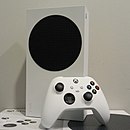
Back إكس بوكس سيريس إكس/إس Arabic اكس بوكس سيرياس اكس ARZ Xbox Series X and Series S Byelorussian Xbox heuliadoù X/S Breton Xbox Series X i Series S Catalan ئێکس بۆکس سیریز ئێکس و سیریز ئێس CKB Xbox Series X a Series S Czech Xbox Series German Xbox Series X/S Greek Xbox Series X kaj Series S Esperanto
 | |
Left: Xbox Series X with controller Right: Xbox Series S with controller | |
| Developer | Microsoft Gaming |
|---|---|
| Manufacturer | Flex, Foxconn |
| Product family | Xbox |
| Type | Home video game consoles |
| Generation | Ninth |
| Release date |
|
| Introductory price | |
| Units sold | 28.3 million (as of June 2024)[1] |
| Media |
|
| Operating system | Xbox System Software |
| CPU | |
| Memory |
|
| Storage | |
| Removable storage | Seagate or Western Digital PCIe 4.0 Storage Expansion Card (up to 2 TB) |
| Display | |
| Graphics |
|
| Sound |
|
| Controller input |
|
| Connectivity | |
| Power | Built-in power supply (both consoles) |
| Current firmware | 10.0.26100.2239[3] |
| Online services | Xbox network, Xbox Game Pass |
| Dimensions |
|
| Weight |
|
| Backward compatibility | All Xbox One games and select Xbox 360 and original Xbox games[a] |
| Predecessor | Xbox One |
| Website | xbox.com |
The Xbox Series X and Xbox Series S are the fourth generation of consoles in the Xbox series. Released on November 10, 2020, the higher-end Xbox Series X and lower-end Xbox Series S are part of the ninth generation of video game consoles, which also includes Sony's PlayStation 5, released the same month.[4] Both superseded the Xbox One.
Like the Xbox One, the consoles use an AMD 64-bit x86-64 CPU and GPU. Both models have solid-state drives to reduce loading times, support for hardware-accelerated ray-tracing and spatial audio, the ability to convert games to high-dynamic-range rendering using machine learning (Auto HDR), support for HDMI 2.1 variable refresh rate and low-latency modes, and updated controllers. Xbox Series X was designed to nominally render games in 2160p (4K resolution) at 60 frames per second (FPS). The lower-end, digital-only Xbox Series S, which has reduced specifications and does not include an optical drive, was designed to nominally render games in 1440p at 60 FPS, with support for 4K upscaling and ray tracing.[5] Xbox Series X/S are backwards-compatible with nearly all Xbox One-compatible games and accessories (including Xbox 360 and original Xbox games that were made backward-compatible with Xbox One); the newer hardware gives games better performance and visuals. At launch, Microsoft encouraged a "soft" transition between generations, similar to PC gaming, offering the "Smart Delivery" framework to allow publishers to provide upgraded versions of Xbox One titles with optimizations for Xbox Series X/S.
Critics praised the Xbox Series X/S for the hardware improvements over Xbox One and Microsoft's emphasis on cross-generation releases, but believed that the games available at launch did not fully use the hardware capabilities.
Xbox Series consoles have estimated to have sold over 28 million units worldwide as of June 2024.[1]
- ^ a b Gerblick, Jordan (September 17, 2024). "Xbox Series X/S sales are reportedly less than half of the PS5's, with Microsoft on track for a repeat of PS4 vs Xbox One". Games Radar. Retrieved October 3, 2024.
- ^ a b Cite error: The named reference
No Kinectwas invoked but never defined (see the help page). - ^ "What's new: Xbox system updates". Microsoft. Archived from the original on October 9, 2024. Retrieved October 16, 2024.
- ^ Rogers, Carter. "Playstation 5, Xbox Series X Bring Sony-Microsoft Rivalry To A New Generation". NPR.org. Archived from the original on November 13, 2020. Retrieved November 13, 2020.
- ^ Cite error: The named reference
wincentral series swas invoked but never defined (see the help page).
Cite error: There are <ref group=lower-alpha> tags or {{efn}} templates on this page, but the references will not show without a {{reflist|group=lower-alpha}} template or {{notelist}} template (see the help page).

